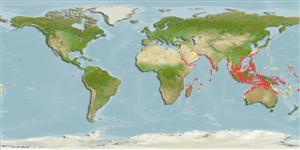Common names from other countries
>
Clupeiformes (Herrings) >
Dorosomatidae (Gizzard shads and sardinellas)
Etymology: Amblygaster: Greek, amblys = darkness + Greek, gaster = stomach (Ref. 45335).
More on author: Walbaum.
Environment: milieu / climate zone / depth range / distribution range
Ecologia
marinhas; estuarina associadas(os) a recifes; intervalo de profundidade 10 - 75 m (Ref. 12260). Tropical; 35°N - 28°S, 31°E - 178°W (Ref. 188)
Indo-West Pacific: Red Sea and Mozambique to the Philippines, north to Taiwan and Okinawa (Japan), south to New Guinea, the Arafura Sea (Ref. 9819), northern Australia, and Fiji.
Length at first maturity / Tamanho / Peso / Idade
Maturity: Lm 15.0 range ? - ? cm
Max length : 27.0 cm SL macho/indeterminado; (Ref. 54980); common length : 20.0 cm SL macho/indeterminado; (Ref. 188); Idade máx. registada: 8 anos (Ref. 1488)
Espinhos dorsais (total) : 0; Raios dorsais moles (total) : 13 - 21; Espinhos anais: 0; Raios anais moles: 12 - 23. Diagnosis: Body slender, belly rather rounded, scutes not prominent (Ref. 188). It is distinguished from Amblygaster clupeoides and A. leiogaster by the presence of a series of 10-20 gold, in life, or black, on preservation, spots down the flank, but sometimes missing; also, lower gillrakers 33-43, while 26-33 in the other two species (Ref. 188). Sardinops species are also round-bodied and have spots on the flanks, but possess bony radiating striae on the gill cover; round-bodied Sardinella species have one unbranched and 8 branched pelvic finrays while Amblygaster sirm has one unbranched and 7 branched pelvic finrays, and more than 100 gillrakers are present in Sardinella species, also no spots (Ref. 188). Last 2 anal-fin rays enlarged (Ref. 117228).
A pelagic, schooling species occurring in coastal waters and lagoons (Ref. 188, 53568), at depths of 1-75m (Ref. 82332). In Panggang Island, Indonesia it was recorded in temperatures of 28.5-29.8°C and salinities of 31.6-32.3 ppt (Ref. 823). It feeds mainly on copepods, nauplii and zoea larvae, larval bivalves and gastropods, as well as Peridinium and Ceratium; juveniles also on phytoplankton (Ref. 188). Used as bait in the tuna fishery.
Spawn in school (Ref. 205).
Whitehead, P.J.P., 1985. FAO Species Catalogue. Vol. 7. Clupeoid fishes of the world (suborder Clupeoidei). An annotated and illustrated catalogue of the herrings, sardines, pilchards, sprats, shads, anchovies and wolf-herrings. FAO Fish. Synop. 125(7/1):1-303. Rome: FAO. (Ref. 188)
Categoria na Lista Vermelha da IUCN (Ref. 130435)
CITES (Ref. 128078)
Not Evaluated
Ameaça para o homem
Harmless
Utilização humana
Pescarias: espécies comerciais; isco: usually
Ferramentas
Relatórios especiais
Descarregue XML
Fontes da internet
Estimates based on models
Preferred temperature (Ref.
115969): 26.2 - 29.1, mean 28.2 (based on 1152 cells).
Phylogenetic diversity index (Ref.
82804): PD
50 = 0.5625 [Uniqueness, from 0.5 = low to 2.0 = high].
Bayesian length-weight: a=0.00851 (0.00738 - 0.00981), b=3.04 (3.00 - 3.08), in cm Total Length, based on LWR estimates for this species (Ref.
93245).
Nível Trófico (Ref.
69278): 2.9 ±0.30 se; based on food items.
Resiliência (Ref.
120179): Elevada, tempo mínimo de duplicação da população menor que 15 meses (K=0.37-3.74; tm=1; tmax=8; Fec > 10,000).
Fishing Vulnerability (Ref.
59153): Low vulnerability (16 of 100).
